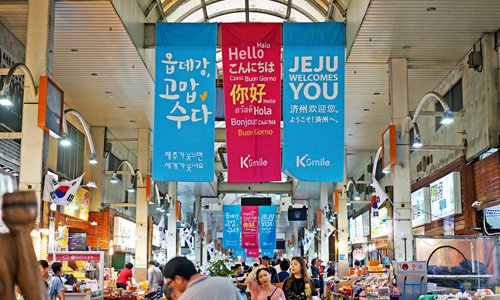First Chinese cruise to South Korea in 6 years not fully booked amid safety, health concerns

A market on Jeju Island uses eye-striking scrolls written in Chinese, Korean and other languages to attract customers during the post-THAAD period. Photo: VCG
South Korea is welcoming the first cruise from China heading to Jeju Island after a six-year hiatus. However, Chinese analysts have a cautiously optimistic view about the sector's prospects, as the load factor is lower than expected amid political uncertainties in bilateral relations.
Sailing from Shanghai Baoshan Port, the Blue Dream Star started its five-day trip to Nagasaki in Japan via Jeju Island in South Korea, according to the official website of the operator, Blue Dream Cruises China.
It is the first cruise sailing to South Korea after China resumed the third batch of group tours to 78 countries and regions in August.
The Jeju Island government announced that as of August 17, a total of 267 cruise ships departing from China had applied for midway berthing at Jeju Port and Gangting Port, indicating a possible "tide" of Chinese group tourists.
The Global Times learned that Blue Dream Star carried fewer than 800 passengers during its stop in South Korea. The 25,000-ton cruise ship can carry 1,053 travelers.
The cruise company re-started services on May 26 and has since operated 16 voyages, serving more than 22,000 passengers. It had a full load for every cruise during the summer peak, according to Chinanews.com on August 19.
"My family will cancel our bookings for the upcoming trip to South Korea and Japan, although it will cost us 70 percent of the full ticket price," Feng Xiaorui, a traveler from Wuxi, East China's Jiangsu Province told the Global Times on Wednesday.
Safety and health issues are major concerns of Chinese travelers. Feng said the family is worried about health and safety as Japan is dumping nuclear-contaminated water into the sea.
"At the moment, I'd prefer to travel domestically," she said. "South Korea also does not appear to be safe... besides, traveling in China is also very interesting and cost-effective," she added.
Due to the COVID-19 pandemic and political issues, international cruise services between China and South Korea were halted for a long time and the South Korean tourism industry has suffered a major blow.
Currently, the South Korean government's policy toward China has negatively influenced Chinese travelers' views of the country, Xiang Haoyu, a research fellow at the China Institute of International Studies, told the Global Times in an earlier interview.
In the first half of this year, the number of Chinese travelers to South Korea stood at 546,000, just 19.5 percent of the level in the first half of 2019, according to news outlet News.cn on August 15, citing the Korea Tourism Organization.
According to data released by the organization on August 14, South Korea's travel deficit exceeded $4.65 billion in the first half of this year, the highest since the first half of 2018.
South Korea's tourism industry relies heavily on Chinese tourists, and the industry experienced its largest deficit in 2017, when the number peaked at about $14.7 billion. This came after the Chinese government issued a group travel ban in the wake of the Terminal High Altitude Area Defense dispute.
China attaches great importance to trade and economic ties with South Korea and hopes to maintain strategic communication, resolve differences, enhance economic exchanges and achieve mutual benefit and win-win results, Li Tianguo, an associate professor at the National Institute of International Strategy of the Chinese Academy of Social Sciences, told the Global Times on Wednesday.
Chinese tourists now favor domestic travel, according to a report published by travel platform Ctrip. During the summer holiday peak, the number of ticket bookings for domestic tourist attractions was up 315 percent from 2019.
